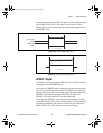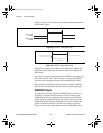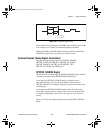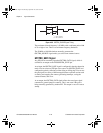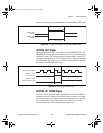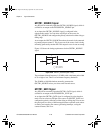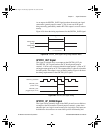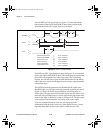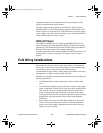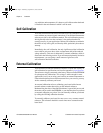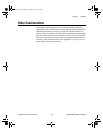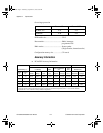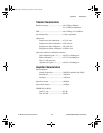
Chapter 4 Signal Connections
©
National Instruments Corporation 4-49 PCI-6023E/6024E/6025E User Manual
arrangement results in an uncertainty of one source clock period with
respect to unsynchronized gating sources.
The OUT output timing parameters are referenced to the signal at the
SOURCE input or to one of the internally generated clock signals on the
boards. Figure 4-41 shows the OUT signal referenced to the rising edge of
a source signal. Any OUT signal state changes occur within 80 ns after the
rising or falling edge of the source signal.
FREQ_OUT Signal
This signal is available only as an output on the FREQ_OUT pin. The
board’s frequency generator outputs the FREQ_OUT pin. The frequency
generator is a 4-bit counter that can divide its input clock by the numbers 1
through 16. The input clock of the frequency generator is
software-selectable from the internal 10 MHz and 100 kHz timebases. The
output polarity is software-selectable. This output is set to tri-state at
startup.
Field Wiring Considerations
Environmental noise can seriously affect the accuracy of measurements
made with your board if you do not take proper care when running signal
wires between signal sources and the board. The following
recommendations apply mainly to analog input signal routing to the board,
although they also apply to signal routing in general.
Minimize noise pickup and maximize measurement accuracy by taking the
following precautions:
• Use differential analog input connections to reject common-mode
noise.
• Use individually shielded, twisted-pair wires to connect analog input
signals to the board. With this type of wire, the signals attached to the
CH+ and CH– inputs are twisted together and then covered with a
shield. You then connect this shield only at one point to the signal
source ground. This kind of connection is required for signals traveling
through areas with large magnetic fields or high electromagnetic
interference.
• Route signals to the board carefully. Keep cabling away from noise
sources. The most common noise source in a PCI data acquisition
system is the video monitor. Separate the monitor from the analog
signals as much as possible.
PCI.book Page 49 Wednesday, September 16, 1998 9:09 AM



